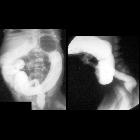fecaloma

Koprolith
über mehrere Monate nachweisbar: Randständig verkalkte Formation (gut 5 cm) rechts in das Becken projiziert, 10 Monate zuvor in ähnlicher Position in der Computertomografie nachweisbar. Im Verlauf zunehmende ossäre Metastasierung bei Mammakarzinom.

Dünndarmileus
durch Kotstein im terminalen Ileum, bei mehreren großen Dünndarmdivertikeln im Jejunum möglicherweise in einem von diesen entstanden. Computertomografie oben axial und sagittal, unten koronar und schräg. Man erkennt eine Art Kuppelphänomen des impaktierten Steines mit vorgeschaltet deutlich erweiterten Dünndarmschlingen.


A case of
perforation of Meckel’s diverticulum with enterolith. Preoperative enhanced computed tomography (CT) images. Enhanced a, b coronal and c axial CT images showed an enterolith (arrowhead) in a tubular blind-ending structure, with a thickened and hypercaptant wall (arrow)
A fecaloma is a mass of feces most frequently noted in the rectum and sigmoid colon, that is much harder than a fecal impaction due to coprostasis.
Clinical presentation
Symptoms are non-specific and include constipation, abdominal pain, anorexia, nausea, vomiting, overflow diarrhea, fecal incontinence and urinary symptoms from pressure.
Pathology
Usually, the fecal matter accumulates in the intestine, then stagnates and increases in volume until the intestine becomes deformed and acquires characteristics similar to those of a tumor.
Etiology
There are several causes of chronic constipation and fecaloma, for example:
- immobility (e.g. post-operatively, stroke, psychiatric illness)
- medication related (e.g. opioids)
- neurological conditions (e.g. Parkinson disease, Hirschsprung disease)
- neoplastic conditions (e.g. colorectal cancer)
- inflammatory conditions (e.g. inflammatory bowel disease)
- infective conditions (e.g. Chagas disease)
- functional conditions (e.g. irritable bowel syndrome)
Radiographic features
CT
A fecaloma should be considered when there is evidence of focal fecal material of equal or greater diameter than the colon.
Complications
Siehe auch:
- Koprostase
- Morbus Hirschsprung
- Appendizitis
- chagas disease
- röntgendichtes Material im Kolon
- Koprolith in Meckel-Divertikel
- Kolitis bei impaktierter Fäzes
- Perforation bei Stuhlimpaktation
- Ileus durch Kotstein
und weiter:

 Assoziationen und Differentialdiagnosen zu Koprolith:
Assoziationen und Differentialdiagnosen zu Koprolith:




